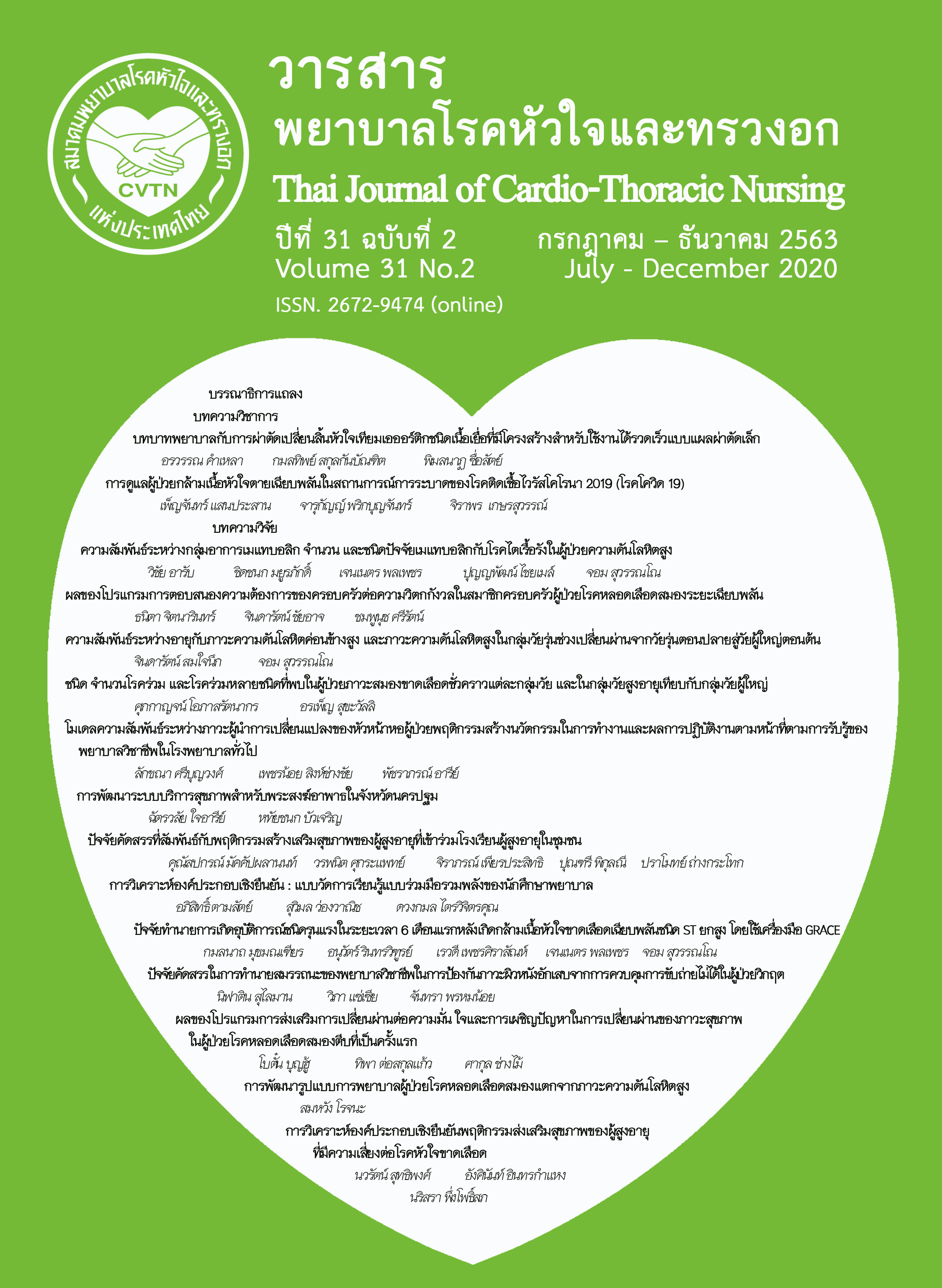์ ปัจจัยคัดสรรในการทำนายสมรรถนะของพยาบาลวิชาชีพในการป้องกันภาวะผิวหนังอักเสบจากการควบคุมการขับถ่ายไม่ได้ในผู้ป่วยวิกฤต
คำสำคัญ:
ภาวะผิวหนังอักเสบจากการควบคุมการขับถ่ายไม่ได้, ระยะเวลาการปฏิบัติงาน, สิ่งแวดล้อมที่ส่งเสริมการปฏิบัติงาน, ระบบเกื้อหนุน, สมรรถนะของพยาบาลบทคัดย่อ
การวิจัยเชิงทำนาย มีวัตถุประสงค์เพื่อศึกษาอำนาจการทำนายของระยะเวลาการปฏิบัติงานในหอผู้ป่วยวิกฤต การได้รับอบรมเกี่ยวกับการป้องกันภาวะผิวหนังอักเสบจากการควบคุมการขับถ่ายไม่ได้ (incontinence-associated dermatitis [IAD]) ปัจจัยด้านสิ่งแวดล้อมที่ส่งเสริมการปฏิบัติงาน และปัจจัยด้านระบบเกื้อหนุน ต่อสมรรถนะของพยาบาลวิชาชีพในการป้องกัน IAD ในผู้ป่วยวิกฤต กลุ่มตัวอย่างเป็นพยาบาลวิชาชีพที่มีประสบการณ์ปฏิบัติงานในหอผู้ป่วยวิกฤต จำนวน 100 คน เครื่องมือที่ใช้ ประกอบด้วยแบบสอบถามการรับรู้สมรรถนะของพยาบาลวิชาชีพในการป้องกันภาวะ IAD ในผู้ป่วยวิกฤต แบบสอบถามปัจจัยด้านสิ่งแวดล้อมที่ส่งเสริมการปฏิบัติงาน และแบบสอบถามปัจจัยด้านระบบเกื้อหนุน วิเคราะห์อำนาจการทำนายโดยใช้สถิติวิเคราะห์ความถดถอย
ผลการศึกษา พบว่า สมรรถนะในการป้องกันภาวะ IAD ในผู้ป่วยวิกฤตอยู่ในระดับปานกลาง และพบว่ามีเพียงปัจจัยด้านสิ่งแวดล้อมที่ส่งเสริมการปฏิบัติงาน และปัจจัยด้านระบบเกื้อหนุน ที่สามารถร่วมกันทำนายสมรรถนะของพยาบาลวิชาชีพในการป้องกันภาวะ IAD ในผู้ป่วยวิกฤตได้ร้อยละ 39.5 (Adj. R2 = .395, p < .001)
ผลการศึกษาครั้งนี้ เป็นข้อมูลพื้นฐานที่สามารถใช้เป็นแนวทางในการพัฒนาโปรแกรมส่งเสริมสมรรถนะของพยาบาลในการป้องกันภาวะ IAD สำหรับผู้ป่วยวิกฤตต่อไป
เอกสารอ้างอิง
Beeckman D. A decade of research on incontinence-associated dermatitis (IAD): evidence, knowledge gaps and next steps. J Tissue Viability. 2017; 26: 47-56.
Uppanisakorn S, Sommai T, Vattanaprasan P. Prevention and treatment of incontinence-associated dermatitis (IAD) in critical patients treated in the intensive care unit of a medical ward. Thai Journal of Nursing Council. 2015; 30(2): 86-100. (in Thai).
Jack L, Coyer F, Courtney M, Venkatesh, B. Diarrhoea risk factors in enterally tube fed critically ill patients: a retrospective audit. Intensive Crit Care Nurs. 2010; 26(6): 327-34.
Valls-Matarin J, Cotillo-Fuente M, Ribal-Prior R, Pujol-Vila M. Sandalinas-Mulero I. Incidence of moisture-associated skin damage in an intensive care unit. Enferm Intensiva. 2017; 28(1):13-20.
Demarre L, Verhaeghe S, Hecke AV, Clays E, Grypdonck M, Beeckman D. Factors predicting the development of pressure ulcers in an at-risk population who receive standardized preventive care: secondary analyses of a multicentre randomised controlled trial. J Adv Nurs. 2015; 71(2): 391-403.
Damme NV, Clays E, Verhaeghe S, Hecke, AV, Beeckman D. Independent risk factors for the development of incontinence-associated dermatitis (category 2) in critically ill patients with fecal incontinence: a cross-sectional observational study in 48 ICU units. Int J Nurs Stud. 2018; 81: 30-9.
Park KH, Choi H. Prospective study on incontinence-associated dermatitis and its severity instrument for verifying its ability to predict the development of pressure ulcers in patients with fecal incontinence. Int Wound J. 2016; 13(s1): 20-5.
Junkin J, Selekof JL. Prevalence of incontinence and associated skin injury in the acute care in patient. J Wound Ostomy Continence Nurs. 2007; 34(3): 260-69.
Pather P, Hines S, Kynoch K, Coyer F. Effectiveness of topical skin products in the treatment and prevention of incontinence-associated dermatitis: a systematic review. JBI Database of System Rev Implement Rep. 2017; 5(5): 1473–96.
Fukada M. Nursing competency: definition, structure and development. Yonago Acta Med. 2018; 61(1): 1-7.
Wound, ostomy and continence nurses society task force. Wound, ostomy, and continence nursing: scope and standards of WOC practice, 2nd edition an executive summary. J Wound Ostomy Continence Nurs. 2018; 45(4): 369-87.
Chunbang S, Wongvatunyu S, Aree-Ue S. Selected factors related to nursing practice for preventing increased intracranial pressure in patients with brain surgery. Ramathibodi Nursing Journal. 2013; 19(2): 264-76. (in Thai).
Rizany I, Hariyati RTS, Handayani H. Factors that affect the development of nurses’ competencies: a systematic review. Enferm Clin. 2018; 28: 154-7.
American Association of Critical-Care Nurses. AACN standards for establishing and sustaining healthy work environments: a journey to excellence. Am J Crit Care. 2018; 4(3): 187-97.
Wongtawan T, Prachusilpa G. A study of the roles of enterostomal therapy nurse. Thai Red Cross Nursing Journal. 2017; 10(2): 121-39. (in Thai).
Gray M. Incontinence-related skin damage: essential knowledge. OWM 2007;53(12):28–32.
Uangnakhon M, Abhicharttibutra K, Chontawan R. Development of a competency framework for registered nurses, surgical intensive care unit, Chiang Rai Prachanukroh hospital. Nursing Journal. 2016; 43: 129-39. (in Thai).
Hirunpinyopas A, Prachusilpa G. Predicting factors of competency of professional nurses in coronary care unit. Thai Journal of Cardio-Thoracic Nursing. 2016; 27(2): 71-84. (in Thai).
Srisatidnarakul B. The methodology in nursing research. 5 th ed. Bangkok: U&I inter media; 2010. (in Thai).
Benner P. Form novice to expert: excellence and power in clinical nursing practice. Menlo Park, California: Addison-Wesley; 1984.
Phungsiri P. The effect of utilizing work instruction for incontinence associated dermatitis in high risk patient. Region 11 Medical Journal. 2016; 30(1): 59-67. (in Thai).
Liou S. R., Cheng C. Y. Organizational climate, organizational commitment and intention to leave amongst hospital nurses in Taiwan. J Clin Nurs. 2010; 19: 1635-44.
Sinwisarn N. Wisesrith W. Relationships between working experiences, educational training, emotional intelligence, working environment, and nurse competency in cardiothoracic surgical ward, the tertiary hospital. Thai Journal of Cardio-Thoracic Nursing. 2019; 30(1): 46-59. (in Thai).
Salonen AH, Kaunonen M, Meretoja R, Tarkka MT. Competence profiles of recently registered nurses working in intensive and emergency settings. J. Nurs. Manag. 2007; 15(8): 792-800.
Wanthanatas R. Factors affecting professional nurses’ performance based on the nursing process at Nakhonpathom hospital, Nakhonpathom province. Nursing Journal of the Ministry of Public Health. 2016; 26(2): 103-15. (in Thai).
Wattradul D, Jamsomboon K, Sanprasan P, Suthipong N, Taechaveerakorn N, Prousoontron M. Factors influencing to knowledge management of cardiovascular nursing in registered nurses. Thai Journal of Cardio-Thoracic Nursing. 2016; 27(2): 85-99. (in Thai).
Srepatarapinyo J. Knowledge, skill and indicators for specific nursing care in the 5 southern border provinces. Nonthaburi: Nursing Division, Ministry of Public Health. 2008; 55-66. (in Thai).
ดาวน์โหลด
เผยแพร่แล้ว
รูปแบบการอ้างอิง
ฉบับ
ประเภทบทความ
สัญญาอนุญาต
บทความนี้ยังไม่เคยตีพิมพ์หรืออยู่ในระหว่างส่งไปตีพิมพ์ในวารสารอื่น ๆ มาก่อน และกองบรรณาธิการขอสงวนสิทธิ์ในการตรวจทาน และแก้ไขต้นฉบับตามเกณฑ์ของวารสาร ในกรณีที่เรื่องของท่านได้ได้รับการตีพิมพ์ในวารสารฉบับนี้ถือว่าเป็น ลิขสิทธิ์ของวารสารพยาบาลโรคหัวใจและทรวงอก






